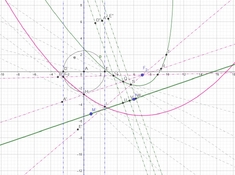Korbel
Subscriber
The idea is to make an extremely fast lens by focusing a medium format on a tiny film. It is a work in progress I have abandoned around a year ago and maybe it could inspire someone or spark a discussion, or maybe I got it completely wrong.
RB67 has a long flange distance (around 10cm) while for instance micro 4/3 has around 1cm. This gives a quite large distance for a mirror based speedbooster.
In the design I came up with there are two parabolic mirrors (magenta and green). The blue rays are what enters the speedbooster, magenta rays are first reflection and green rays are second.
UW is the film size and DE is the size of image exiting a lens.
I think that the blue rays are ideally parallel when exiting lenses. Such an ideal lens would simplify the design quite a lot, because you can have static elements. Sadly I don't think this is always the case on RB67 system, because I notice quite big focus breathing with my 100-200mm lens. Anyways a measurement of the angle for the lens in a whole focus / zoom range should be done. Worst case you could just focus to infinity and do astral photography with ridiculously fast lens - the area is almost 5x smaller, hence it is 5x brighter, then f3.5 = f0.7.
This project could get even crazier if you take those huge projector lenses!
Mirrors optics shouldn't suffer from aberrations, because the refractive index isn't an issue. There is a slight distortion to the image, UV is around 110% of VW.
Maybe I got some things wrong, I did read a book on optics by Kingslake, Lens Design Fundamentals. On the first few pages he basically said the best one can do is educated trial and error I found that funny because I found it as recommendation for the best optics book.
I found that funny because I found it as recommendation for the best optics book.
Uploading the geogebra file too if someone wants to play around.
RB67 has a long flange distance (around 10cm) while for instance micro 4/3 has around 1cm. This gives a quite large distance for a mirror based speedbooster.
In the design I came up with there are two parabolic mirrors (magenta and green). The blue rays are what enters the speedbooster, magenta rays are first reflection and green rays are second.
UW is the film size and DE is the size of image exiting a lens.
I think that the blue rays are ideally parallel when exiting lenses. Such an ideal lens would simplify the design quite a lot, because you can have static elements. Sadly I don't think this is always the case on RB67 system, because I notice quite big focus breathing with my 100-200mm lens. Anyways a measurement of the angle for the lens in a whole focus / zoom range should be done. Worst case you could just focus to infinity and do astral photography with ridiculously fast lens - the area is almost 5x smaller, hence it is 5x brighter, then f3.5 = f0.7.
This project could get even crazier if you take those huge projector lenses!
Mirrors optics shouldn't suffer from aberrations, because the refractive index isn't an issue. There is a slight distortion to the image, UV is around 110% of VW.
Maybe I got some things wrong, I did read a book on optics by Kingslake, Lens Design Fundamentals. On the first few pages he basically said the best one can do is educated trial and error
 I found that funny because I found it as recommendation for the best optics book.
I found that funny because I found it as recommendation for the best optics book.Uploading the geogebra file too if someone wants to play around.
Attachments
Last edited:



